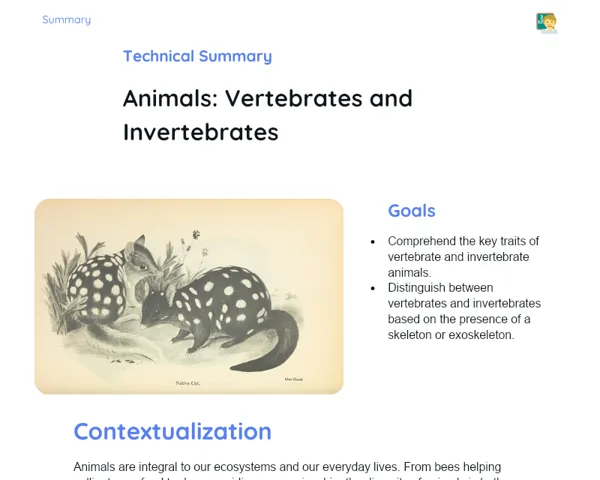Summary Tradisional | Animals: Types of Excretion
Contextualization
Excretory processes are vital for all living creatures, allowing them to get rid of metabolic waste that can be harmful if it builds up. Each type of waste plays a significant role in maintaining homeostasis, which is the balance of bodily functions. Take ammonia, for instance – it’s extremely toxic and dissolves easily in water, primarily excreted by aquatic animals like fish. If not eliminated quickly, it can be damaging to them, especially in water-rich environments where it can be diluted effectively.
On the other hand, urea and uric acid are less toxic forms of waste that help conserve water, which is often a scarce resource on land. Mammals produce urea in the liver and expel it through their kidneys, while birds and reptiles eliminate uric acid in a solid or paste form. These evolutionary adaptations are crucial for thriving in dry habitats, where saving water is essential. By understanding the different ways animals excrete waste and how these methods relate to their environments, we gain better insight into the survival strategies that allow various species to flourish.
To Remember!
Ammonia
Ammonia is a highly toxic waste that needs quick removal from the body to prevent damage. It dissolves in water, which is why many aquatic animals, such as fish and invertebrates, excrete it directly. In water-rich environments, ammonia is released into the surrounding water, where it can be swiftly diluted. This makes ammonia a suitable waste option for creatures living in these habitats. The process involves ammonia diffusing through the gills or body surface directly into the water.
However, ammonia is problematic for land animals, where water is a more limited resource. For these animals, fast elimination of ammonia is essential to prevent toxic build-up in the body. Aquatic creatures benefit from ammonia's high solubility, allowing them to eliminate it without needing excessive amounts of water.
-
Ammonia is highly toxic and must be removed quickly.
-
It dissolves in water, allowing aquatic animals to excrete it easily.
-
Rapid dilution in water aids in its elimination in aquatic environments.
Urea
Urea is less toxic than ammonia and can be kept in the organism for a while before being excreted. It is produced in the liver of mammals through a cycle known as the urea cycle, where ammonia is converted into urea, which is safer and transported via the bloodstream to the kidneys for excretion.
This method allows mammals to conserve water more effectively, which is a crucial adaptation for life on land. Urea is expelled through urine by the kidneys, enabling mammals to maintain a proper balance of fluids in their bodies. This process is critical for survival in places where water is hard to come by.
Moreover, urea is not immediately harmful, allowing mammals to store it temporarily without the risk of toxicity. This flexibility supports mammals in managing waste based on available water and physiological needs.
-
Urea is less toxic than ammonia and can be stored for a while.
-
It is created in the liver and taken out through the kidneys.
-
Helps conserve water, vital for survival in terrestrial habitats.
Uric Acid
Uric acid is the least toxic waste out of the three discussed and is typically excreted in solid or paste form. This method saves a lot of water, which is crucial for surviving in dry conditions. Birds, reptiles, and many insects excrete uric acid, helping them preserve water in environments where availability is low.
Excreting uric acid is an evolutionary adaptation that allows these animals to reduce water loss while eliminating nitrogenous waste. Since uric acid is less soluble in water, it is released in a more concentrated form, avoiding the need for water that would be required to dissolve and excrete ammonia or urea.
This trait is particularly beneficial for birds and reptiles in arid environments, such as deserts. The capacity to excrete uric acid aids these animals in maintaining water balance, which is critical for their survival in extreme climates.
-
Uric acid is the least toxic waste and is excreted in a solid or paste form.
-
Conserves a notable amount of water, essential for dry environments.
-
Common in birds, reptiles, and many insects, aiding in water conservation.
Evolutionary Adaptations in Excretory Systems
Adaptations in animals' excretory systems highlight the necessity of maintaining homeostasis and ensuring survival across different ecosystems. The evolution of these systems arises from environmental pressures and varying metabolic demands in different animal groups. For example, in water-rich environments, ammonia excretion is preferred because water can dilute this toxic by-product quickly.
In contrast, urea and uric acid excretion represents adaptations aimed at conserving water for life on land and in dry conditions. Mammals benefit from the ability to excrete urea, allowing them to conserve water – a crucial survival trait. Similarly, the solid or pasty excretion of uric acid permits birds and reptiles to reduce water loss, a key factor for thriving in dry habitats.
These adaptive traits showcase the diversity and flexibility of excretory systems among animals, enabling them to thrive in a range of ecological niches. Understanding these adaptations is essential for grasping the distribution and behaviours of various species in differing ecosystems.
-
Adaptations reflect the need for homeostasis and survival.
-
Ammonia excretion is favoured in aquatic environments because of abundant water.
-
Urea and uric acid excretion are strategies for conserving water in land and arid settings.
Key Terms
-
Excretion: The method by which organisms remove metabolic waste.
-
Ammonia: Toxic waste, water-soluble, expelled by many aquatic animals.
-
Urea: Less toxic waste than ammonia, created in the liver of mammals and expelled by the kidneys.
-
Uric Acid: A less toxic waste excreted in solid or paste form, found in birds, reptiles, and insects.
-
Homeostasis: The internal balance of bodily functions.
-
Toxicity: The potential of a substance to cause harm to living beings.
-
Evolutionary Adaptation: Changes that improve survival and reproductive success in specific environments.
-
Aquatic Environments: Habitats dominated by water.
-
Terrestrial Environments: Habitats where land is the main setting.
Important Conclusions
The various excretion methods — ammonia, urea, and uric acid — play crucial roles in maintaining homeostasis among different animal groups. Ammonia is quickly excreted by aquatic species because of its high toxicity, benefitting from abundant water for dilution. In contrast, urea and uric acid are less toxic wastes that help conserve water, essential for survival on land and in arid environments, respectively.
These evolutionary adaptations in excretory systems are fundamental for the survival of animals in their unique habitats. Mammals, birds, and reptiles have developed effective ways to save water, enabling them to thrive in areas where it’s scarce. Understanding these excretory processes offers meaningful insights into the evolutionary and ecological strategies of animals.
Knowledge of the different types of excretion and their evolutionary strategies is vital for academic fields like biology, environmental science, and conservation. Recognising how animals manage waste enables us to predict how various species might react to environmental changes and to create effective conservation practices.
Study Tips
-
Review diagrams and images of different animal excretory systems to visualise these processes.
-
Take detailed notes on each waste type and examples of animals, focusing on evolutionary adaptations.
-
Engage in discussions and activities with colleagues to apply concepts to various ecological and evolutionary contexts.



